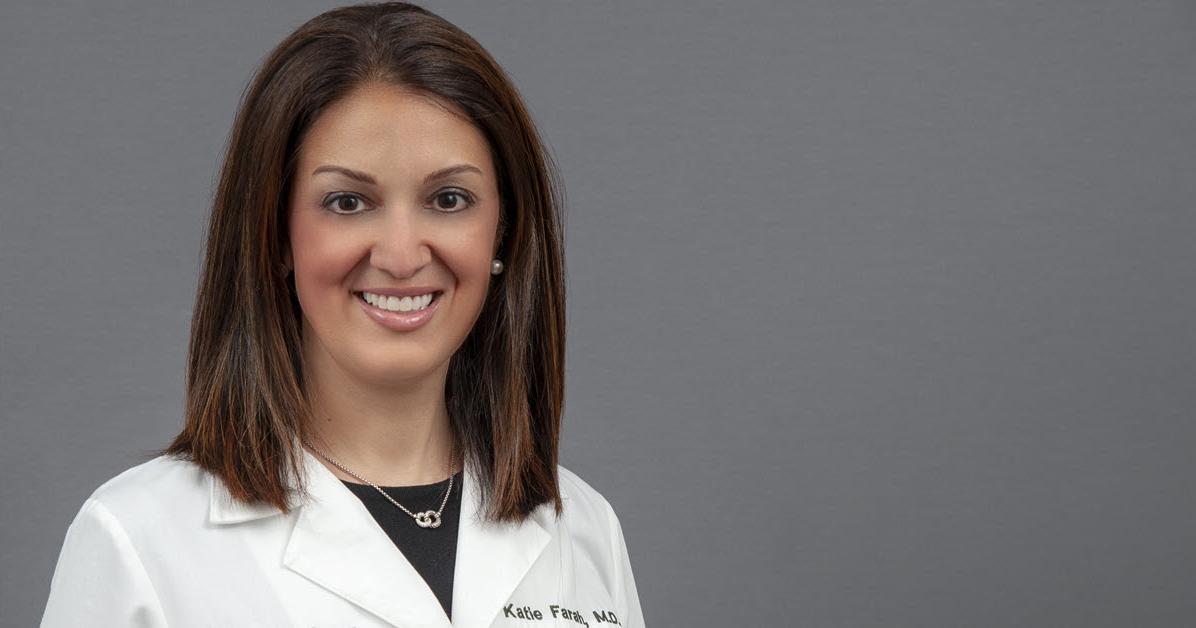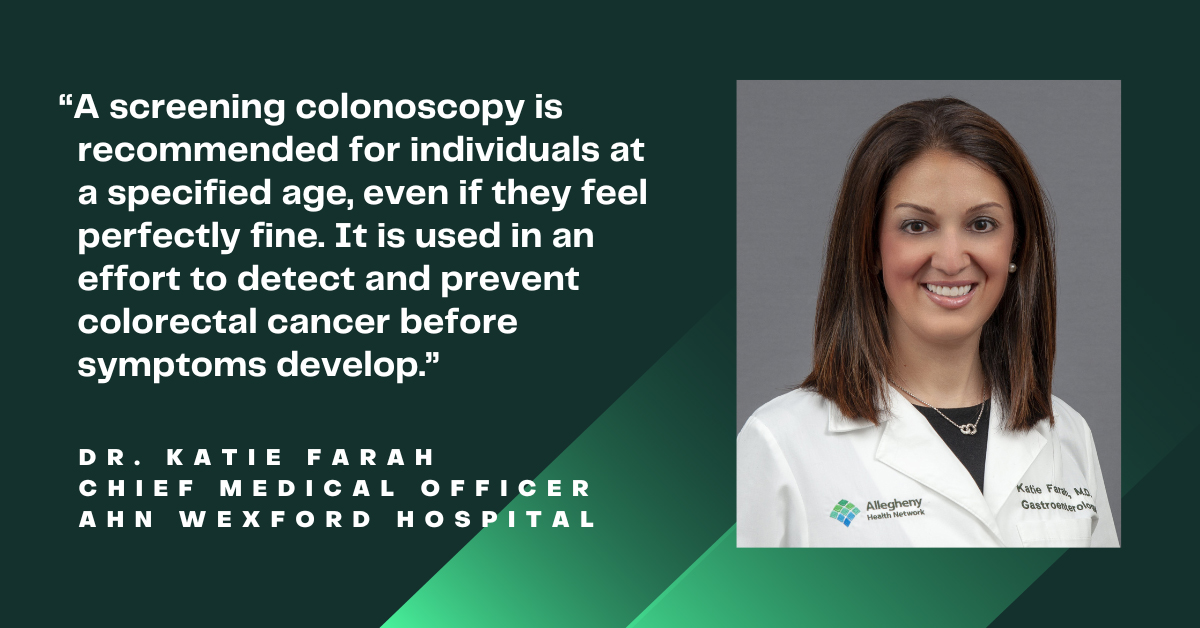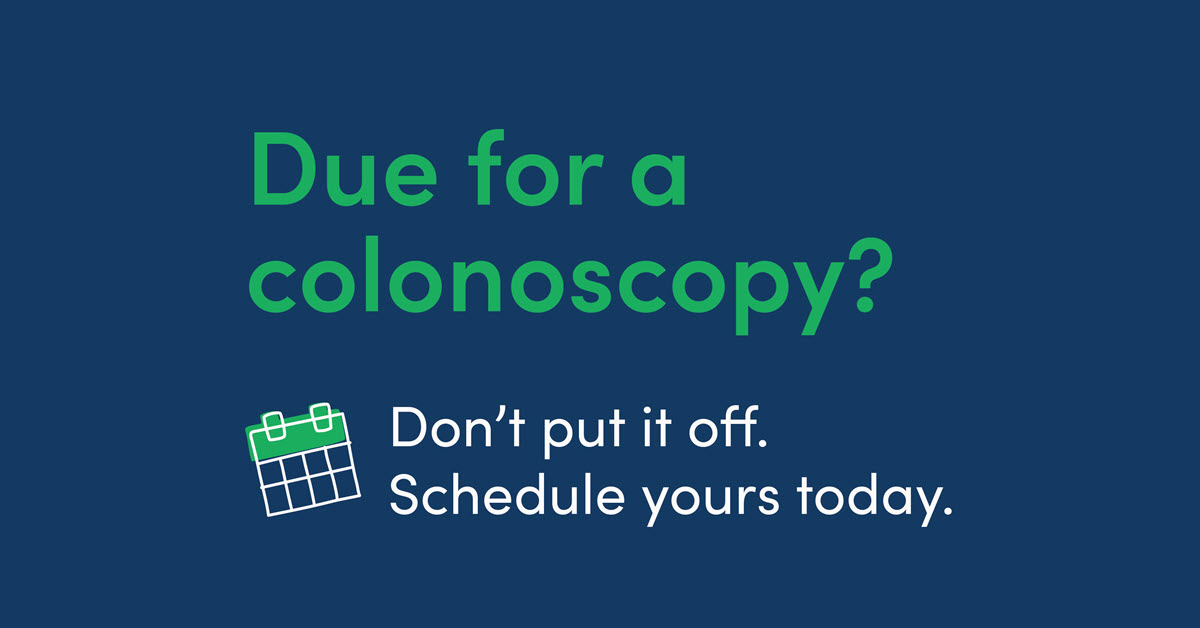In our Ask a Doc series, we sit down with physicians and other clinical experts, including those at Allegheny Health Network (AHN), for a chat on an important health topic. In this post, we talk about colorectal cancer and screenings with Dr. Katie Farah, chief medical officer at AHN Wexford Hospital, and a practicing gastroenterologist and therapeutic endoscopist.
Editor's Update: This article was first published April 21, 2020. It was most recently reviewed and updated February 28, 2023.
Colorectal cancer is the second leading cause of cancer-related deaths worldwide, but approximately 60% of colorectal cancer deaths could be prevented with recommended screenings. Unfortunately, screening is highly underutilized, in part due to apprehension and misconception about the procedure, as well as an awareness gap and lack of accessibility in underserved communities. To learn more about this important topic, I spoke with Katie Farah, MD, chief medical officer at AHN Wexford Hospital, and a practicing gastroenterologist and therapeutic endoscopist.

Dr. Katie Farah, chief medical officer, AHN Wexford Hospital
Emily Adamek: Dr. Farah, what are the different screening options for colorectal cancer?
Dr. Katie Farah: There are several modalities, but the best screening tests are colonoscopy and fecal immunochemical test (FIT), respectively.
A colonoscopy is the best test for colorectal cancer screening. The GI Multi-Society Task Force guidelines provide tier-based testing to give practitioners guidance, and based on an overwhelming amount of evidence, colonoscopy is the number one test of choice.
The next best screening modality, FIT, is a stool-based test that has the highest sensitivity and specificity for picking up colon cancer and the majority of colon polyps.
Emily Adamek: Are there other options that you would deter people from using?
Dr. Katie Farah: The tier-based classification that I mentioned represents the most up-to-date, evidence-based recommendations from the American College of Gastroenterology, the American Gastroenterological Association, and The American Society for Gastrointestinal Endoscopy. We want patients as well as primary care providers (PCPs) and other referring physicians to use the tier 1 screening tests — that’s colonoscopy as the first test of choice and, if refused by the patient, an annual standard FIT test as the second tier 1 option.
Another test that patients and PCPs may hear about is Cologuard (FIT-fecal DNA), an at-home product that combines FIT to detect blood in the stool with a DNA component. The guidelines currently consider Cologuard (FIT-fecal DNA every three years) among the tier 2 testing options due to disadvantages that include decreased specificity in patients older than 65, high cost relative to the standard FIT, and higher relative costs related to higher number of colonoscopies per test. The higher false positivity rate in older patients can lead to significant anxiety as well. We are always glad to answer questions that patients or PCPs have about any of the other options for colon cancer screening, but ultimately we follow tier 1 recommendations as set forth by the Multi-Society Guidelines and American Society for Gastrointestinal Endoscopy.
Getting back to the standard FIT, one issue that we’ve been trying to address is to close the loop between patients taking a test and getting it back to their physician. We found that 10% to 30% of standard FIT tests were not leading to colonoscopy, even if the test came back positive for colorectal cancer. We have done FIT KIT campaigns with the goal of increasing the rate of return to colonoscopy after a positive FIT.
One barrier has been that when a non-invasive stool test is positive, the follow-up colonoscopy has been considered a diagnostic colonoscopy, rather than a screening colonoscopy. A screening colonoscopy is covered, but a diagnostic colonoscopy may involve out-of-pocket costs for the patient. As of 2023, new CMS guidelines allow a screening colonoscopy following a positive result from a non-invasive test. The Medicare Physician Fee Schedule now places the service as a screening, so patients will not have any out-of-pocket costs for the service. A positive result from a non-invasive stool-based colorectal cancer screening test no longer requires that the following colonoscopy be a diagnostic colonoscopy. Colorectal cancer screening tests now include a follow-on screening colonoscopy after a Medicare-covered, non-invasive, stool-based colorectal cancer screening test returns a positive result. This helps remove barriers to the patient obtaining a follow-up colonoscopy after a non-invasive stool test is positive.
Emily Adamek: Aside from the billing and coverage issue, can you explain the clinical difference between a diagnostic colonoscopy and a screening colonoscopy?
Dr. Katie Farah: A screening colonoscopy is performed in a patient without any symptoms for purposes of preventive care. A diagnostic colonoscopy is guided by the patient's symptoms and/or abnormal imaging. An example would be a CAT scan showing an abnormality in the colon, which would be investigated by performing a colonoscopy.
Emily Adamek: When something is wrong, it’s easy to understand why you should get a procedure. But why are recommended screening colonoscopies important…even if you are healthy?

Dr. Katie Farah: The biggest misconceptions about colon cancer are, “I have no symptoms, so I don’t need a screening,” or “it’s not going to happen to me because I don’t have a family history.”
A screening colonoscopy is recommended for individuals at a specified age, even if they feel perfectly fine. It is used in an effort to detect and prevent colorectal cancer before symptoms develop. The timing of the screening is determined by the patient’s age and risk profile. The guidelines are set to maximize the risk-benefit ratio based on their risk factors.
If, during a colonoscopy, we find a polyp or pre-cancerous growth, we remove it at the same time, and in that case, we’ve prevented possible future growth which could develop into cancer down the road. Even if a mass is found, screening gives us an opportunity to catch colorectal cancer early. For stage-one colorectal cancer, long-term survival is similar to the overall population. And the majority of patients with early diagnosis will not require additional treatment such as chemotherapy or radiation.
Emily Adamek: That seems pretty convincing. So, who needs a screening colonoscopy and when?
Dr. Katie Farah: There are two major categories — normal risk and high risk for colorectal cancer. The major risk factors are family history of colorectal cancer, ulcerative colitis, Crohn’s disease, a personal history of colorectal polyps or colon cancer, and some rare hereditary colon cancer conditions such as Lynch Syndrome. Familial colon cancers pose a higher risk and therefore the patient is usually screened at age 40 or 10 years prior to the age that their first-degree relative was diagnosed.
The latest guidelines have decreased the age to 45 for colon cancer screening for all average-risk patients.

Emily Adamek: When the American Cancer Society suggested moving the first screening for colorectal cancer back to age 45, there was initially some disagreement. Can you give some insight on the debate?
Dr. Katie Farah: Based on an increase (numbers have doubled) in colon cancer patients between age 21 and 49, extensive research has been performed to determine the right age for screening. The American Cancer Society board of directors — made up of well-respected, highly-skilled thought leaders — did research based on modeling in which a specific birth cohort was analyzed as an attempt to identify who is more at risk in the younger population. They concluded that age 45 is a good age to start screening for all asymptomatic patients. The U.S. Preventive Services Taskforce has also endorsed age 45 as the screening age for average-risk patients, as have our GI societies.
We also need to raise awareness around early symptoms. There are patients in their twenties and thirties with no risk factors showing up with colorectal cancer. When you look at how long they’ve been complaining of symptoms before diagnosis, it ranges anywhere from a few weeks to two years. That is why we are now educating primary care physicians (PCPs) to have heightened awareness that, regardless of age, if a patient comes in with anemia, rectal bleeding, change in bowel habits, and/or abdominal pain, then a referral to a gastroenterologist should be made.
Emily Adamek: When you perform a screening colonoscopy, is identifying and removing polyps the main focus?
Dr. Katie Farah: We look for anything abnormal, including polyps. Most polyps can be removed endoscopically. If there is mucosal abnormality, biopsies are taken. We evaluate for diverticular disease, which are little pockets in the colon that can lead to diverticulitis, as well as any evidence of inflammatory bowel disease, just to name a few.
Emily Adamek: How often will a person need to get additional screenings?
Dr. Katie Farah: For the average-risk patient, if there is no polyp on first examination, typically a follow-up colonoscopy is in 10 years. However, surveillance intervals vary based on polyp number, polyp size, and pathology of the polyp. That interval may be sooner if the physician needs to evaluate the polyp site sooner or if there is a poor preparation. Patients with hereditary colorectal cancer and prior history of colon cancer will get surveillance colonoscopy at more regular intervals.
Research is also being performed to evaluate the role of annual FIT testing in younger patients at this time.

Among other benefits, a preventive colonoscopy screening allows clinicians to identify and remove polyps in the colon that could later develop into cancer.
Emily Adamek: Why do you think people are apprehensive about colonoscopy screenings?
Dr. Katie Farah: We have surveyed people across Allegheny Health Network and there seem to be three main reasons: fear of complications, fear of anesthesia, and fear of the preparation.
Emily Adamek: Ok, let’s address those. Are there possible complications associated with colonoscopy?
Dr. Katie Farah: Most risk factors happen in less than 1% to 2% of patients and would include but are not limited to perforation, bleeding, infection, complications of anesthesia, and injury to other organs. These are rare, but nonetheless, risks are reviewed with the patient prior to procedure.
Emily Adamek: What about anesthesia — can people choose to undergo the procedure without it?
Dr. Katie Farah: Generally, most patients receive monitored anesthesia. However, there will be an occasional patient who does not want anesthesia, and yes it can be done. Most gastroenterologists have performed colonoscopy on patients unsedated, albeit few. It is less favored due to patient discomfort and technical difficulty with a patient who is awake. My personal practice is that I schedule the patient as the last patient of the day as it may take longer due to the patient being awake. If they have discomfort, I either abort the procedure or ask that they be converted to anesthesia at that point. It would be the patient’s decision if we are faced with that type of situation. Reasons why a patient might be apprehensive about receiving anesthesia include a history of anxiety, sense of loss of control, and prior trauma in their life. I have found that most patients just want to be able to trust their physician, be able to have that discussion and be heard.
Emily Adamek: Are there any revisions to the preparation process that would help people who struggle with that?
Dr. Katie Farah: We are constantly revising the preparation process, with our main concerns being safety, efficacy, and tolerability. Over the last few years, literature has shown that split-dose preparation is the best option — whatever type of preparation you have, split it in two. Patients will take the first half the night before and the second half after midnight, with the goal of finishing about four hours prior to the procedure. This is helpful because your colon evacuates chyme and bile in those last few hours, and dumps them into the right colon — the area where most flat polyps and cancers are missed. Therefore, we want to ensure evacuation of this region, and by splitting the preparation, this is accomplished in most cases. There are emerging preparations coming into the market in an effort to improve tolerability for patients.
Tips we give to make the preparation more tolerable are to keep it in the fridge overnight, sip it through a straw, add lots of ice, and mix it with any clear liquid.
Emily Adamek: What would you say to people who still feel uneasy about colonoscopies?
Dr. Katie Farah: First, I recommend seeing a gastroenterologist in the office, so they can establish a relationship, and have their questions answered in person. It’s important for people to make sure they trust their physician. In addition, proper education is of utmost importance. I always indicate that having colon cancer would be worse.
One thing about the Internet is that people can do a lot of research on their physician, and that can also be reassuring. I’ll add that we measure every gastroenterologist throughout AHN. They get a scorecard, so they know how they’re performing compared to standard national benchmarks and compared to their peers locally, regionally, and nationally.
Emily Adamek: Earlier, you mentioned educating PCPs, and I know there is also a lot of attention at AHN to community outreach, recognized by numerous SCOPY awards from the American College of Gastroenterology. Can you talk about those efforts?
Dr. Katie Farah: For many people, awareness and education starts with their PCP — the vector of medical information. That’s why we’ve been conducting webinars across AHN to make sure PCPs have the best information.
But you also have to think about people who don’t have a PCP, especially people in underserved communities. So we promote education through community events, social media, and local media. For instance, we did a sponsorship event at a Pittsburgh Pirates game that stressed the importance of getting colorectal cancer screenings. We handed out flyers, t-shirts, pens, bracelets — we even had a 20-foot-wide inflatable colon. Every year, we also advertise at the Riverhounds soccer games at the Highmark Stadium. Our most recent SCOPY awards were in the categories of “High Impact Media Campaign” and “Best Innovative Multilingual Messaging.”
Emily Adamek: Tell me about the AHN Saturday screening initiative.
Dr. Katie Farah: Nationally, about 35% of people remain unscreened. When I asked my patients why they hadn’t been screened, one reason was that they couldn’t take a day off of work. Our team of physicians, nurses, managers, and researchers organized an effort to offer screening colonoscopies at several outpatient endoscopy centers on Saturdays throughout the year. Physicians get a day off if they volunteer, and staff gets overtime. We wanted to build a community-based solution which would benefit all.
We started the program in March 2018 with the intention to be annual, but the demand led to Saturdays quarterly. In addition, we are also faced with the post-pandemic delays in access to care and this poses significant delays to getting the colonoscopy scheduled. This last quarter, within 36 hours almost all the spots were filled. The Saturday screening program to this date has been one of the most successful initiatives that AHN has had to improve access to care on a weekend for our patients.
Another barrier to screening that we identified was lack of reliable transportation. The PALS (People Able to Lend Support) volunteer program has been helping with that.
As important as screening is, I’ll emphasize that it’s just part of our comprehensive Care Model, which includes prevention, screening, diagnosis, treatment, surveillance, survivorship, and end-of-life care. Across that entire continuum, we’re working to understand what patients need and ask what we can do to meet those needs. Providing access and education fulfills a good proportion of those needs.